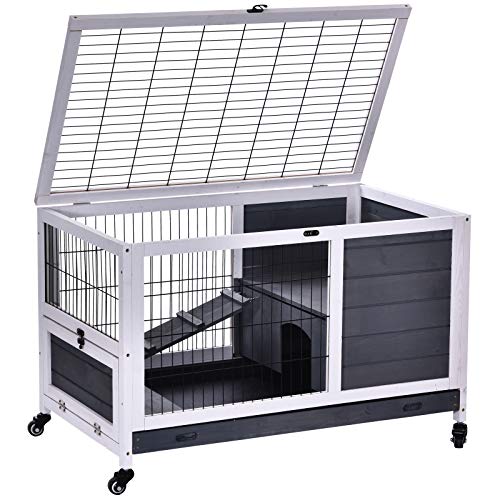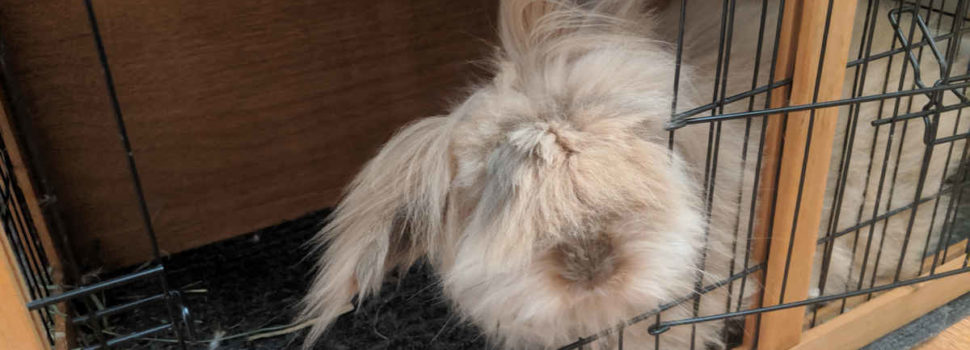
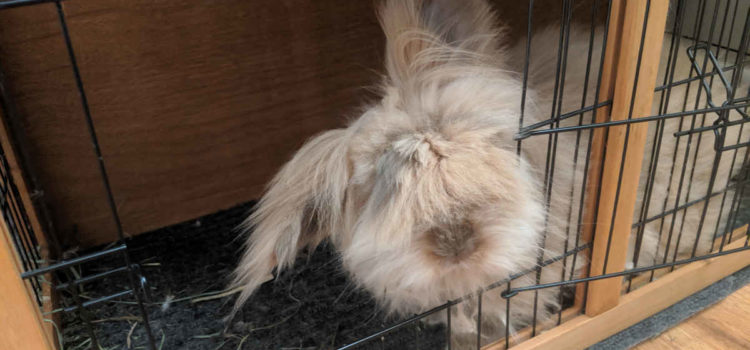
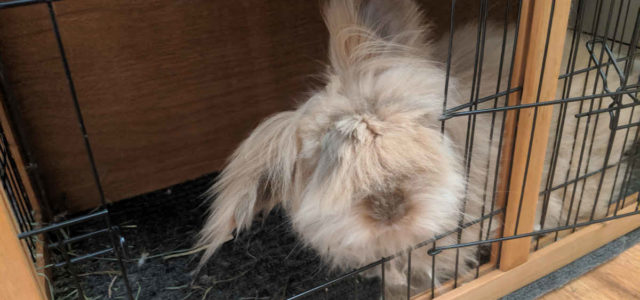
If you’re a first-time rabbit owner and are opting to keep your rabbit indoors, you are in for a big surprise.
Rabbits can sometimes unfairly be seen as dull or boring pets. But this could not be further from the truth. Rabbits are curious, playful and intelligent.
Once a trusting relationship has formed, it is not uncommon for your rabbit to follow you around the home, come over and investigate what you are doing and even hop into your lap for a cuddle. You’ll be surprised at just how affectionate and loveable a rabbit can be.
In this guide you’ll learn:
Why it is a good idea to house your rabbit indoors. What size cage is best. Plus we’ll cover the 6 key things you need to consider when choosing a hutch and what other options are available.
Why Keep Your Rabbit Indoors?
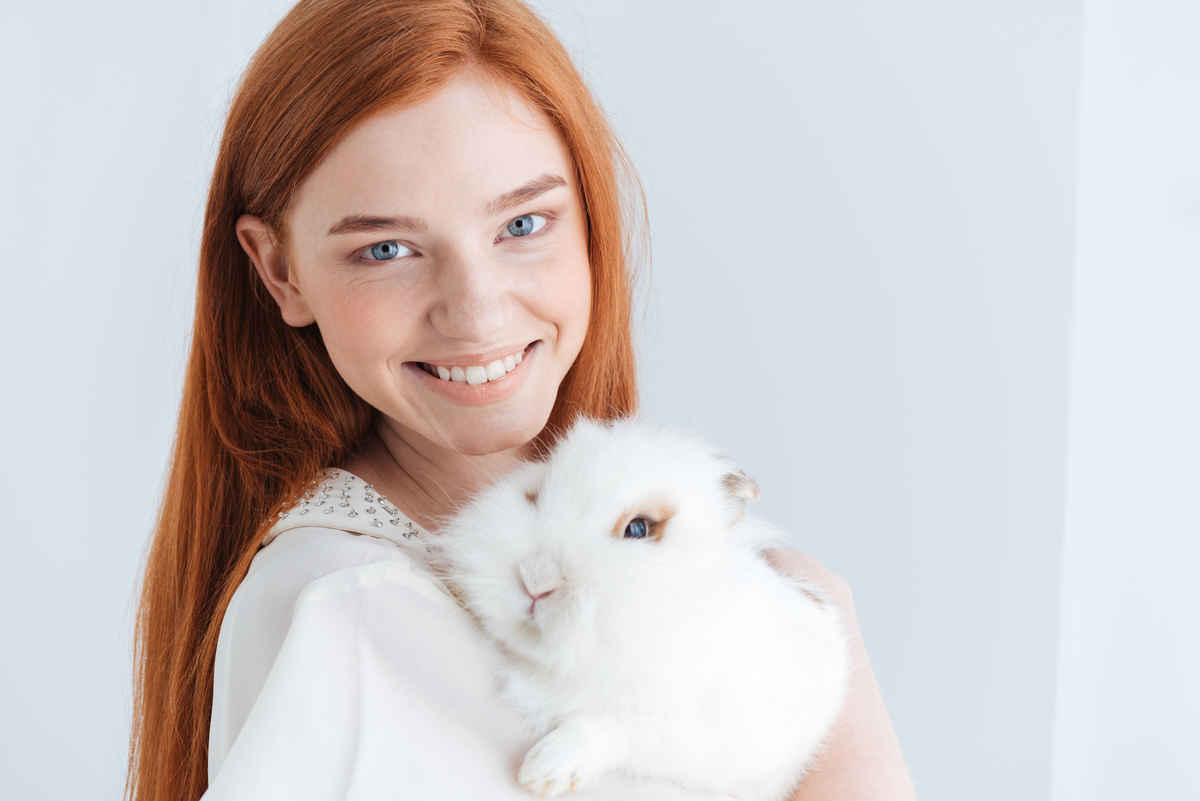
Even today rabbits aren’t typically kept in the home. But, more and more rabbit owners are opting to do this because of the added protection it provides and the increased opportunities for interaction.
Here are some great reasons to keep your rabbit indoors:
You’ll Form A Deeper Bond With Your Bunny
Many indoor rabbit owners form deeper bonds with their rabbits compared to those kept outside.
This not only provides an enriching experience for your rabbit in the form of more stimulation and company but it also allows you to keep a closer eye on your bunny and spot any potential health problems early.
The RSPCA Says Its OK!
Even the RSPCA is not against keeping a rabbit indoors. On their website they state:
QUOTE The RSPCA is not against rabbits being kept in the home, provided this is right for the individual rabbit(s) concerned, the rabbit’s individual needs are met, and the rabbit is healthy and happy.
And a big part of this is choosing the right cage for your rabbit. With this in mind here’s a simple checklist you can follow to help you choose the right cage to make the ideal home for your bunny.
How To Choose The Best Indoor Rabbit Cage – 6 Key Points
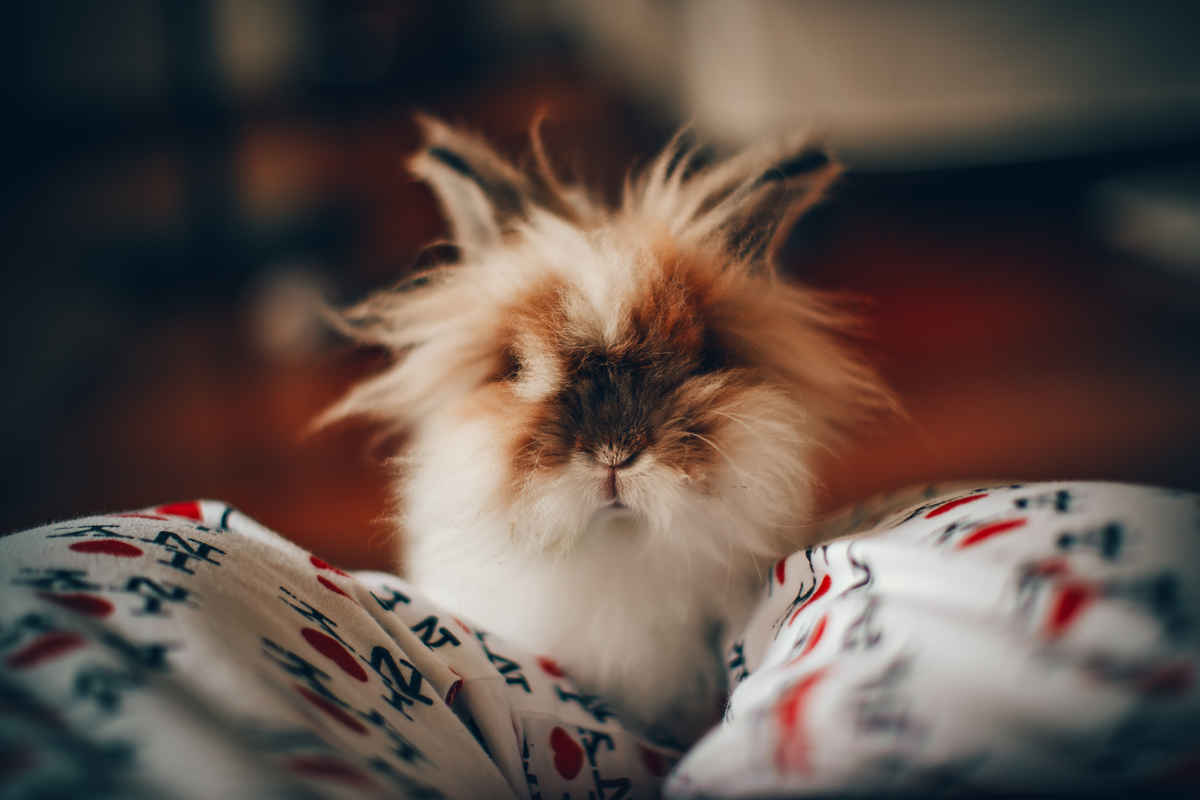
1 What Size Cage Do I Need?
One of the most important concerns regarding a cage is size. And, unlike with outdoor rabbit hutches, the RSPCA hasn’t published any specific dimensions when it comes to minimum recommended size for indoor cages. To complicate matters further there’s a lot of incomplete or slightly confusing advice online which often appears contradictory.
For example, the American Rabbit Breeders Association (ARBA) recommends a minimum of 14 inches in height and anywhere from 1.5 to 4 square feet depending on the size of your rabbit. But, a hutch this size by itself is far too small. Even if your rabbit is let out of its cage in the evening.
In contrast to this, the Rabbit Welfare Association & Fund (RWAF) recommends housing rabbits in an enclosure of 10ft x 6ft with a minimum height of 3ft.
Ok, I’m Confused. What Is The Ideal Size?
The key piece of missing information here that clarifies this contradictory advice is that a hutch is not enough on its own. You always need an accompanying run to place the cage inside. Or allocate a safe, rabbit-proof room for your bunny to run around in when you’re not home, as some people choose to do.
As such we’d recommend a minimum cage size of at least 3 feet wide, by 1 foot deep and at least 1 foot tall. So long as it is placed within a safe indoor run that meets the RWAF’s minimum enclosure guidelines.
2 How Durable Does It Need To Be?
Rabbits are prolific nibblers. From furniture and cables to carpet and wires, they’ll pretty much eat anything they shouldn’t. This means your cage needs to be nibble proof in addition to contending with your rabbit using it as a toilet.
That’s why the rabbit cage wire should be made of metal and the floor made of durable plastic to prevent urine soaking through to your floor and to help make it easier to clean.
Although it might be tempting to buy a cage with a suspended wire floor because they are fast to clean – this is a bad idea. The wire floor is tough on rabbit feet and can lead to sores developing called hocks.
3 Are Multi-Level Cages A Good Choice?
Rabbits love tunnels and platforms and multi-tiered cages provide this form of entertainment built into their design. Some rabbits will like to sit up high in a multi-tier cage (to keep an eye on things) whilst others will enjoy moving up and down the ramps or tunnels that connect the floors.
If you buy a cage with more than 2 tiers just make sure there is no easy way for your rabbit to fall from the top to the bottom floor. Rabbits don’t do well if they’re dropped and even a short drop fall can sometimes be fatal.
4 Buy For An Adult Rabbit
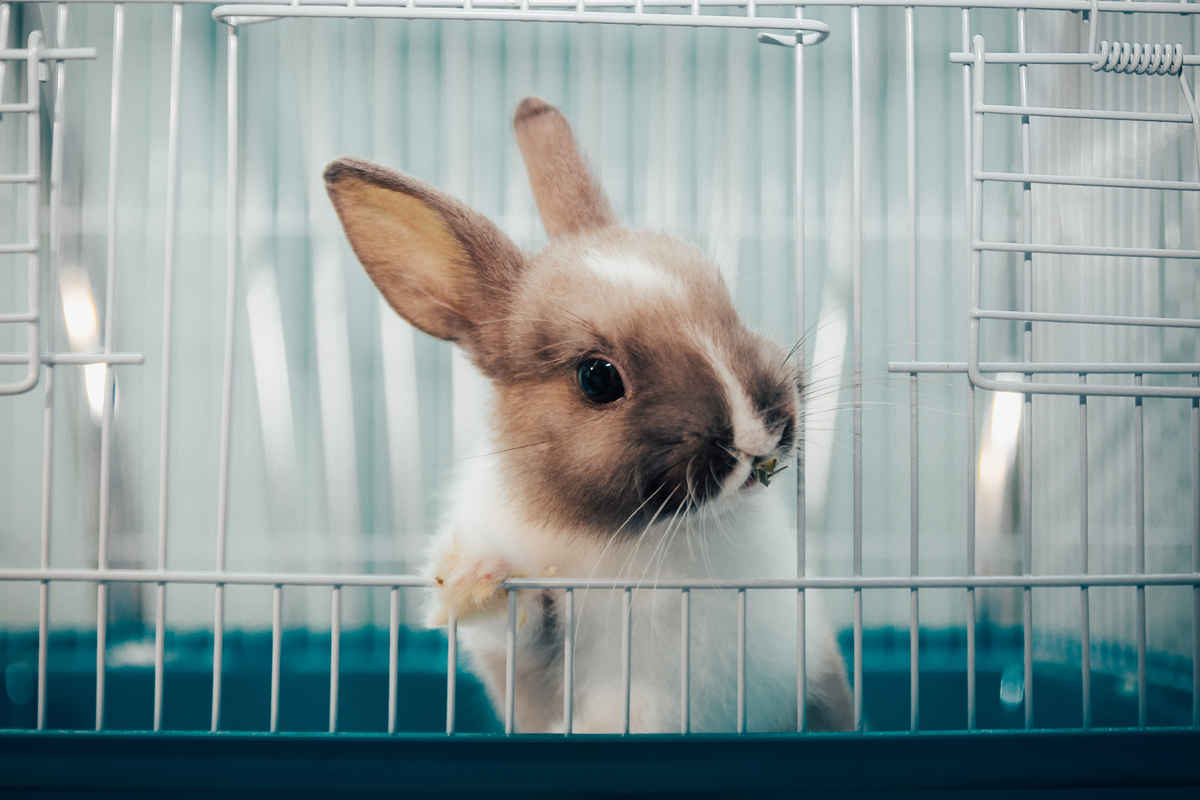
Baby rabbits are small balls of cute fluff – but they don’t stay this way for long. They quickly become large, cute balls of fluff!
So, it’s worth investing in a cage large enough to accommodate an adult rabbit. It will save you money in the long run and ensures your rabbits home is never too small for it to comfortably live in.
5 Watch The Wire Size
Being the curious creatures that they are rabbits will stick there head into gaps and holes they often shouldn’t – including the gaps between the cage wire.
Make sure the wire gaps in the cage you select isn’t wide enough for your rabbit to get its head through and get stuck.
This is especially important to consider when it comes to young rabbits. Their heads are much smaller and can fit into tiny gaps. Plus, their very inquisitive nature means they’ll often stick their heads in places their not supposed to go!
6 Helpful Accessories
A hutch isn’t a home until it has some fun playthings to prevent your rabbit from getting bored and has the right setup to ensure your rabbit feels safe and secure.
Here’s what we recommend your rabbit cage has or your add to it:
A Place To Hide
When rabbits are scared hiding is their natural defence mechanism. It helps them feel safe and this calms them down. And, your rabbit will get startled as some time. Other pets, children or even loud noises might scare it. A place to hide provides a safe retreat.
A Dig Pit
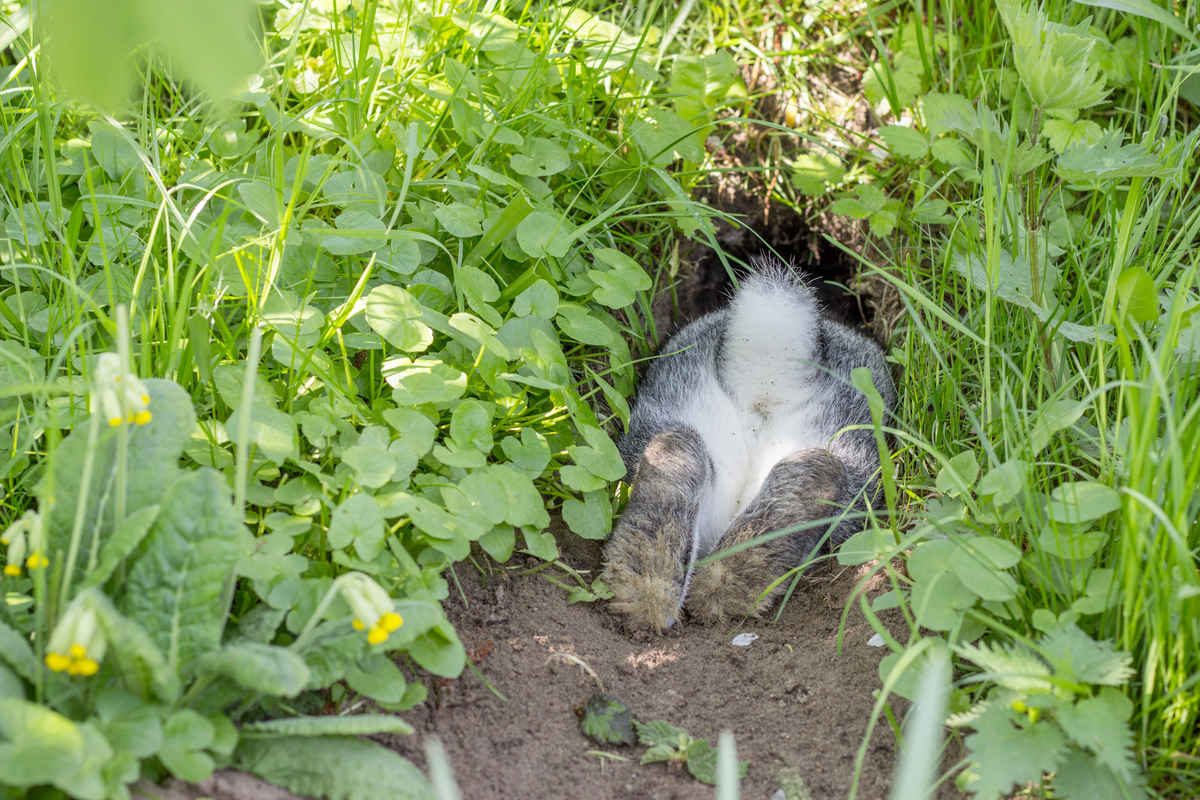
Rabbits love to dig…
As much as they love to nibble rabbits love to dig. Dig pits are often reserved for runs but it doesn’t mean your rabbit can’t have a small one in its hutch.
Dig pits can be a simple as a plastic tray or wooden box 1-2 inches deep that is filled with sand or even shavings. The best part is they are cheap and provide hours of entertainment for you rabbit.
Water Bottle Or Bowl
Your rabbit needs easy access to water. You can provide this using a pet water bottle or bowl. In our experience, every rabbit we’ve owned has preferred to drink from a bowl rather than a bottle.
That said, bottles are convent and can easily hold 2 days worth of water between refills. Plus your rabbit can’t knock over a bottle or stand in the water as they can with bowls.
If you’re unsure try both and see which your rabbit prefers. It might even be a good idea to have both available all of the time.
Bedding Material
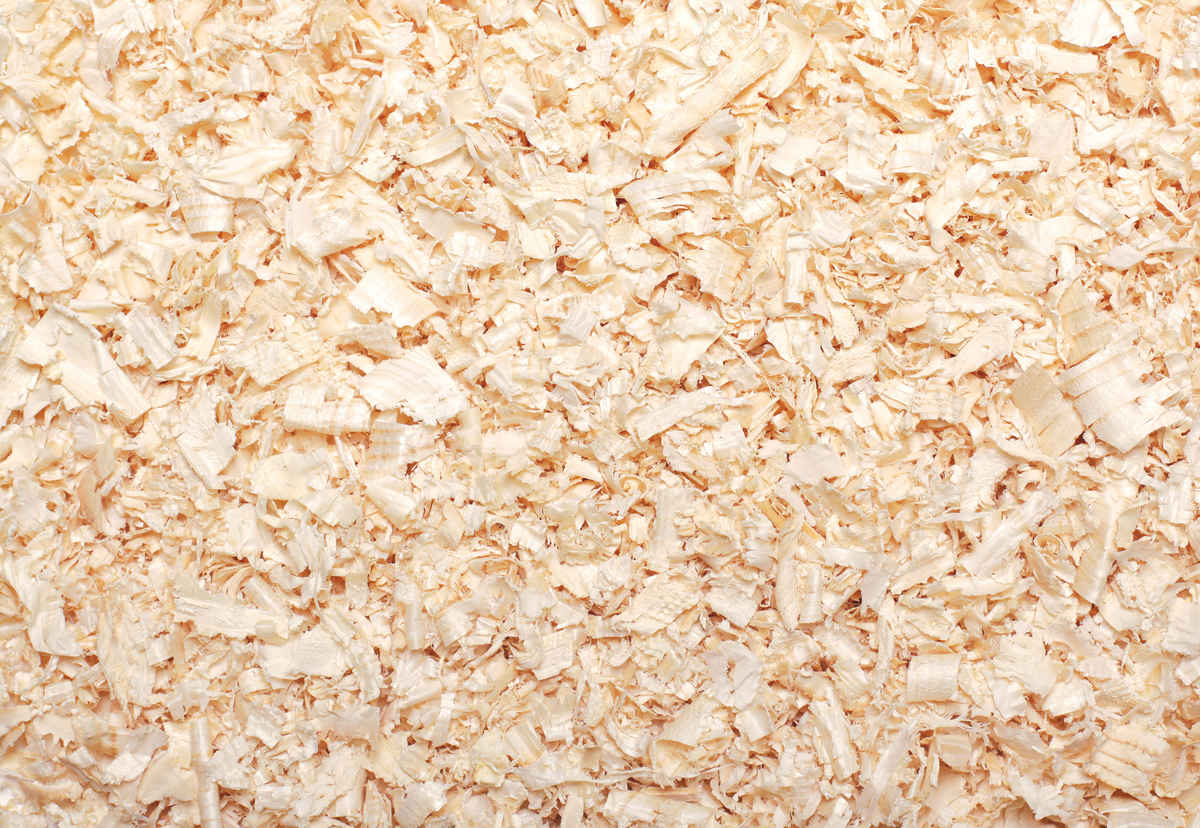 A thin layer of bedding material is all your rabbit will need within your home. It won’t need too much to snuggle up in because your home is a lot warmer than the outside world.
A thin layer of bedding material is all your rabbit will need within your home. It won’t need too much to snuggle up in because your home is a lot warmer than the outside world.
The only exception to this is if your rabbit is housed in colder rooms such as garages. In which case, extra bedding and straw might be needed during the colder times of the year.
For the most part bedding in the home will be used to soak up urine and help keep your rabbit dry. And, when it comes to bedding, you have several main options available.
- The most commonly used bedding material is wood shavings. It is cheap, warm for your rabbit to snuggle in and absorbs urine very well.
- Next on the list is shredded paper. You can buy this in very fine, almost powder-like bails – but it is expensive.
- Lastly you can create your own using a paper shredder. Just make sure there are no staples, plastic or anything else that could harm your rabbit in the paper you shred.
Best Selling Indoor Rabbit Cages
- COMPACT DESIGN: Great for using this rabbit hutch in your home, for you to keep an eye on your...
- THREE INNER AREAS: This guinea pig hutch features a private room, a rooftop and a large open bottom...
- FIR WOOD BODY: This guinea pig house is covered in weather-resistant paint for protection against...
- Cage for adult Rabbits
- Complete with accessories
- Easy to clean
- FOUR WHEELS: Easy to move around the rabbit hutch without disturbing your pet. Two can be locked for...
- FIR WOOD STRUCTURE: Solid and tough, the guinea pig hutch keeps in shape. Water-resistant paint...
- EASY ACCESS: This indoor rabbit hutch features two locking doors, opening roof and pull-out tray to...
Prices & information last updated on 2022-07-23
Choosing The Best Location For An Indoor Cage
Your rabbit needs to be somewhere the temperature won’t get too hot. For example, a conservatory would be a bad location for a hutch because it would be like an oven on summer days. Likewise placing the hutch near a radiator would also be too hot.
Try to choose a room where the temperature stays relatively constant. Getting cooler isn’t too much of a problem but the heat is. Rabbits are prone to heatstroke so it is important you never let your rabbit overheat, and choosing the right location is a big part of this.
Do I Need Anything Else Other Than A Cage?

You’ll need to rabbit proof your home…
Unless your cage meets the rather spacious dimensions described in the ‘What size cage do I need’ section of this guide you will definitely need to provide extra space for your rabbit to run around in.
Generally, people do this one of two ways:
The first is to rabbit-proof a small room in their home. This involves removing all electrical cables out of the reach of your rabbit and anything else dangerous that could be nibbled. Items that could be knocked over and potentially fall on your rabbit also need to be removed. Doing this provides a safe space your rabbit can run around in and stretch its legs.
The second is to build or buy a run and place this around the cage. Many people opt for this approach since it is easier to setup and much easier to guarantee your rabbit is safe. If having a full-size run setup in your home is a problem you can buy folding runs to create the extra space when you need it.
Are There Any Other Kinds Of Indoor Cage?
A new type of housing setup has hit the market in recent years that combines a cage and run into one nifty package. The best part is this setup is highly configurable and expandable allowing it to meet your needs as they change.
This setup consists of a set of square wire sheets and connecting clips. The clips hold the wire sheets together and allows you to create almost any kind of layout. You can even create a small cube to act as your rabbit’s hutch. An example of this kind of setup can be found here.
You will need a few additional accessories such as cover for the ‘cube hutch’ and possibly a large mat to protect your floor. But overall this concept is pretty neat and you can keep your rabbit entertained by creating different layouts for them to explore.
Indoor Rabbit Cages – To Sum Up
With a little planning, your home can be a safe and fun environment for your rabbit to happily live within. Just remember to:
- Buy a robust good-sized cage (NEVER with a wire floor)
- Provide adequate space for your rabbit to exercise either using a run or rabbit-proof room
- Make sure your rabbit is housed away from direct heat sources and not in conservatories or any other room that gets too hot in direct sunlight.
Best Selling Indoor Rabbit Cages
- COMPACT DESIGN: Great for using this rabbit hutch in your home, for you to keep an eye on your...
- THREE INNER AREAS: This guinea pig hutch features a private room, a rooftop and a large open bottom...
- FIR WOOD BODY: This guinea pig house is covered in weather-resistant paint for protection against...
- Cage for adult Rabbits
- Complete with accessories
- Easy to clean
- FOUR WHEELS: Easy to move around the rabbit hutch without disturbing your pet. Two can be locked for...
- FIR WOOD STRUCTURE: Solid and tough, the guinea pig hutch keeps in shape. Water-resistant paint...
- EASY ACCESS: This indoor rabbit hutch features two locking doors, opening roof and pull-out tray to...
Prices & information last updated on 2022-07-23

